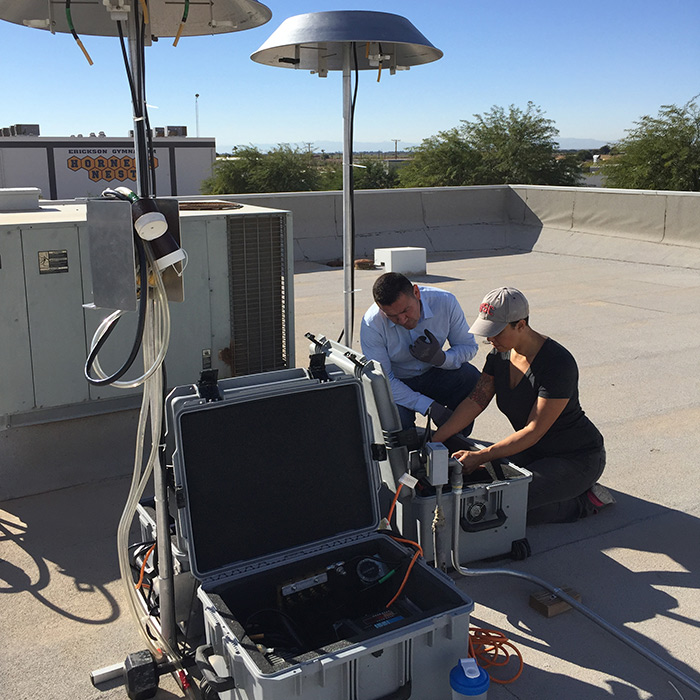Partnerships for Environmental Public Health (PEPH)

The Shrinking Salton Sea and Children’s Health
March 16, 2022
Interviewees: Shohreh Farzan, Ph.D., and Esther Bejarano
In this episode, we talk to NIEHS-funded researcher Shohreh Farzan, Ph.D., and Esther Bejarano, with the community organization Comite Civico del Valle, who have teamed up to address local concerns about the possible health effects of the shrinking Salton Sea. They discuss a community-engaged research project that aims to understand how the rapid drying of the Salton Sea will impact local levels of particulate matter and affect children’s lung health. They also highlight how their community-based approach educates and empowers residents to address local environmental health issues.
(Photo: USC staff member Lisa Valencia shows CCV staff member Humberto Lugo how to set up and operate an air sampler to collect filter-based samples of particulate matter. Photo courtesy of USC AIRE Study Team)
The Shrinking Salton Sea and Children’s Health
The Salton Sea, a 350-square mile lake situated in Imperial Valley, California, is shrinking due to changing weather patterns, drought, and increased water demands. These conditions are drying out the Salton Sea, leaving large portions of the lakebed exposed. Wind-blown dusts from the lakebed potentially contain toxic metals, pesticides, and other particulates. Those dusts could harm the health and life quality of nearby residents who are predominantly low-income Mexican Americans. Residents have expressed concern about the health impacts of exposure to dust from the Salton Sea, especially on children’s respiratory health.
In this episode, we talk to NIEHS-funded researcher Shohreh Farzan, Ph.D., and Esther Bejarano, with the community organization Comite Civico del Valle, who have teamed up to address local concerns about the possible health effects of the shrinking Salton Sea. They discuss a community-engaged research project that aims to understand how the rapid drying of the Salton Sea will impact local levels of particulate matter and affect children’s lung health. They also highlight how their community-based approach educates and empowers residents to address local environmental health issues.
Interviewees:

Shohreh Farzan, Ph.D., is an environmental epidemiologist with a background in molecular biology and toxicology. Much of her research focuses on the impact of toxic metals and air pollutants on maternal and child health, with a special interest in cardiometabolic outcomes. Farzan leads a project at the University of Southern California called the Assessing Imperial Valley Respiratory Health (AIRE) study. It examines how wind-blown dust from the Salton Sea may affect children’s respiratory health. She hopes results from the AIRE study will inform community-engaged public health action.
Esther Bejarano, a program manager for the community organization Comite Civico del Valle, oversees efforts focused on asthma management and education. Bejarano, who is bilingual and bicultural, has over 15 years of experience working as a promotora on asthma health-related studies. She works with schools, health care providers, and the Imperial County Air Pollution Control District in the area of public and environmental health education. Bejarano leads the community engagement and research translation efforts for the AIRE study.
Resources:
- Learn more about the AIRE study at this NIEHS webpage.
- Check out an infographic created by Farzan and team to educate the community about the shrinking Salton Sea and AIRE study.
- This episode mentions asthma burden in California. Learn more about asthma rates in the state at this California Department of Health webpage.
References:
- Farzan SF, Razafy M, Eckel SP, Olmedo L, Bejarano E, Johnston JE. 2019. Assessment of respiratory health symptoms and asthma in children near a drying saline lake. Int J Environ Res Public Health. 16(20):3828. [Full Text Farzan SF, Razafy M, Eckel SP, Olmedo L, Bejarano E, Johnston JE. 2019. Assessment of respiratory health symptoms and asthma in children near a drying saline lake. Int J Environ Res Public Health. 16(20):3828.]
- Johnston JE, Razafy M, Lugo H, Olmedo L, Farzan SF. 2019. The disappearing Salton Sea: A critical reflection on the emerging environmental threat of disappearing saline lakes and potential impacts on children's health. Sci Total Environ. 663:804-817. [Full Text Johnston JE, Razafy M, Lugo H, Olmedo L, Farzan SF. 2019. The disappearing Salton Sea: A critical reflection on the emerging environmental threat of disappearing saline lakes and potential impacts on children's health. Sci Total Environ. 663:804-817.]


